by Jenny Rose | Dec 20, 2018 | A Flourishing Woman, Creativity
Sometimes I spin my wheels.

Photo by Arun Kuchibhotla on Unsplash
I map out a week, a day, a list of directions with mileage and time apportioned to each part of the journey. I ascend the stairs to my expectant workspace, turn on a lamp, plug in a single string of red Christmas lights, light a candle and lift the laptop lid. Outside my windows, tiny snowflakes fill the air. The old-timers here say, “Little snow, big snow,” meaning small flakes indicate significant accumulation. I don’t know if this is always true, but I notice the size of the flakes. As I check the weather forecast, my e-mail and the headlines, my gaze is drawn repeatedly to the window. The hypnotic falling snow is the same color as the sky. Disordered ranks of brown cattail stalks stand ankle-deep in the sleeping pond. An infinity of branch, needle and twig is adorned with an even greater infinity of frozen white crystals, falling soundlessly and blurring the colors of stone and wood.
No snowflake ever falls in the wrong place — Zen saying.
It is then that my wheels start to spin. I have set aside this morning to write. I stare at the laptop screen, fingers on the keyboard. Nothing happens. Seeking inspiration, demanding creativity, I make notes, review notes already made, catch up on reading from favorite blogs and my current stack of books. I search for some solid traction so I can move through the day according to my tidy, efficient plan, but I find myself returning to the window, spellbound, empty of creativity or inspiration but full of wonder at the subtle beauty of the winter snow.
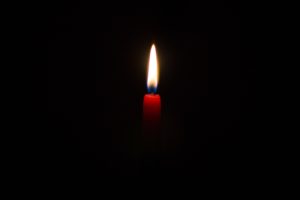
Photo by David Monje on Unsplash
It’s the contrast that catches my attention. My aerie is filled with books, beloved objects, the tools of my life. The warm sticky scent of a red candle fills my space. The red desk lamp I bought at Goodwill more than 10 years ago lights my worktop. My comfortable chair and footstool beckon me to sit and read. The room is warmed by the chimney rising up through it from the woodstove below. I hear my partner talking to our old cat in his office below me; not the words, but the loving sound of his voice that is reserved just for her. He is at his work and I am at mine, cocooned in our private spaces in our slouching farmhouse with lights and heat and the rinsed breakfast dishes stacked on the counter waiting for hot water and soap. We have things to do today, errands to run, people to talk to. We have plans and intentions.

Photo by Galina N on Unsplash
But outside, just beyond the single pane of glass in the old attic windows, is a monochrome world, delicate and cold, still and peaceful. The snow falls without effort. Each flake finds a resting place on the bodies of the trees or the water or the earth. The wood and stone have no place to go and nothing to do. They dwell in the vast power of simply being. The snow settles lightly.
I think about living minimally, weeding out my clothes, the week ahead, money, the perfect Christmas gift I can never find for a loved one, and whether or not we’ll make it into town to do the errands today. I think about drafting a query letter to send out with my first manuscript, which I just finished editing for the fifth or sixth time. I think about reviewing the water rescue information I’ll need next weekend when I travel with a couple of colleagues from work to get deep-water lifeguard certified. It will be a busy week. My careful plan blocks out this morning for coming up with this week’s blog post. I will write … I will begin now … My idea is … Ready, set, go!
My wheels spin, and I look out the window at my little black car, which is wearing a white blanket, and recognize the sinking feeling of no traction. No amount of urgency or frustration makes snow, slush and mud into solid ground. No amount of bullying makes my creativity compliant. I get up. I sit down. I glance at my journal, reread a paragraph in a book, look at some poetry. I feel restless and resentful of my own recalcitrance.
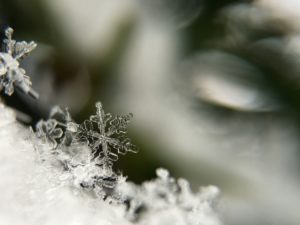
Photo by Aaron Burden on Unsplash
Outside, the snow falls, serene and inexorable as the fading light here in the last handful of days before winter solstice. I open the window and lean close against the hushed, frigid world outside it. My little candle, my lists, my inconsequential blog and my plan for this morning make no impression outside the window screen. It’s time for sleep and dreaming, time for rest. The forest knows, the earth and water know. They lie peacefully under the low sun and the long nights.
My wheels spin, making a noisy mess, throwing clods of half-formed ideas, provocative questions, lingering music of beautiful words, comments and conversations and observations, going nowhere. No traction. The morning is passing. I have not accomplished what I wanted to. I’ve neither rested with the winter snow nor produced a post. I’m torn between self-disgust, resignation and amusement. I think about heavy, cold chains; red, numb hands; wet jeans and sodden gloves; the steady clicking of hazard lights; the feeling of being late and time running out; the texture of wood ash, cat litter, sand and salt thrown onto snow and ice; and the futile laboring of spinning wheels.
The morning is gone. In half an hour we’ll try to go into town. My partner is out with the snow shovel. I shut the window, sit down and open the laptop. I type “Spinning My Wheels” and begin to write this post.

Photo by Teddy Kelley on Unsplash
All content on this site ©2018
Jennifer Rose
except where otherwise noted
by Jenny Rose | Dec 6, 2018 | A Flourishing Woman, Spirit
It’s the season of Christmas music. Like it or hate it, it seems to be inescapable just now. I’ve never understood why “My Favorite Things” is a Christmas song, but it always seems to be in the holiday music lineup, so the lyrics have been winding their way through my thoughts.

Photo by Ludde Lorentz on Unsplash
One of the things I love about life is how multilayered it is, and how, paradoxically, the activities demanding most of our time and energy are not necessarily the things that truly nourish us and make our lives worth living. We can look around and identify a few of our favorite things on the surface of our lives. Several layers underneath the surface, however, is a different list, a list of what we’re rooted in. The loss of surface things is painful. The loss of what we’re rooted in is terminal.
I’ve come to appreciate the complex layers in life gradually. For a long time I was only aware of my shallow roots, and they were in other people. My possessions, my place and the people around me provided me with a sense of identity and I didn’t see myself as separate from them.
In fact, I didn’t see myself at all.
Raindrops on roses and whiskers on kittens certainly enrich my life, but I’m not rooted in them. I don’t draw joy, passion, hope and my desire to engage with life from them.
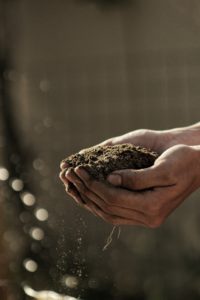
Photo by Gabriel Jimenez on Unsplash
So, I’ve been asking myself for the last few days, what are my roots growing in? What lies in the layers beneath my favorite things and my stories, beliefs and identity? What makes life possible and beautiful?
The resulting list, not of favorite things but of essential things, seems very odd to me. It’s so odd and unexpected, in fact, that I’m wildly curious about how other people would answer these questions. Am I the only odd one, or does everyone have a strange little inventory of necessities in their deepest layers of their experience? I was also surprised at how hard it was to excavate so deeply, far below my desire for seductive surface things I can buy. Making a wish list is easy. Making an external inventory of the stuff in our lives is also not difficult, though it may take some time. Descending deeply within ourselves, past our relationship to others, past our identity and past the things that fire or flood can take from us to scratch and sniff and burrow among our own roots, tasting the soil and filling ourselves with our own scent, is a journey through the dark without guide or companion into our own soul.
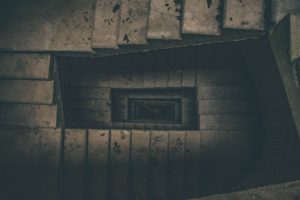
Photo by Riccardo Pelati on Unsplash
In that deep, internal place from which I draw faith, peace, and love reside a memory and a dream. The memory is of a crippled orange cat who taught me everything I know about unconditional love, survival, surrender, and courage. The dream is of my mother, young and carefree, as I have never seen her, leaping and running joyfully down a grassy hill under a blue sky toward a group of waiting horses, dogs and cats.
My roots must mingle with the roots of other lives, especially the patient trees, and always they reach for water in all its forms, as necessary to me as breathing.

Photo by Syd Wachs on Unsplash
I cannot imagine living without stories. My childhood was spent in secret gardens, Oz, Narnia and on the river with Mole, Rat and ridiculous Mr. Toad. The greatest loss of things I can imagine is the loss of my library, but the influence and inspiration of all the stories I’ve read, told, written and even forgotten have shaped me in countless ways that can never be lost. I am never tired of watching, listening to and reading the stories around me, mine, yours and theirs.
Stories are only one aspect of creativity, and creativity is perhaps the strongest support upon which my life rests. The power to make something out of nothing, the power to interpret a piece of life with music, words, dance, fiber, paint or any other material or medium, seems to me the most sacred power there is. The compulsion to make, not for money or fame, but as a love letter to life, animates and inspires me. The work of creativity is the greatest spiritual treasure we can give ourselves, one another and the world.
A dream that all will be well with someone beloved. A memory of a great love. Trees and water, stories and the joy of creation. These are the essential things without which I would not be. A strange assortment that doubtless makes a strangely shaped soul, but I don’t mind. I know who I am, and I know what I need.
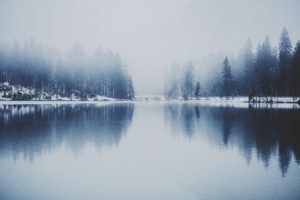
All content on this site ©2018
Jennifer Rose
except where otherwise noted
by Jenny Rose | Nov 8, 2018 | A Flourishing Woman, Body
The pool where I work is part of a rehabilitation center, which is part of a local hospital. There are actually two pools. One is a lap pool of about 84 degrees. The other is a large therapy pool, nearly as big as the 4-lane lap pool. The therapy pool is about 94 degrees. The pool patrons are a mix of the public, hospital staff and rehab patients.
As a lifeguard, I spend hours in an elevated chair watching people in the water and moving around on the deck. It delights me to be paid for doing what I naturally do in the world, which is to people watch. In an environment with a consistent air temperature over 80 degrees with more than 50% humidity, all of us — staff, patrons and patients — are necessarily without our usual armor of clothing, make-up and jewelry. We are physically revealed to one another to an unusual degree in a public place.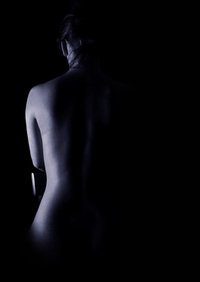
I’m struck every day by the humility of flesh, the wonder and complexity of our physical being; the almost painful innocence of small children with their rounded, unselfconscious forms; the incredible and paradoxical endurance, resilience and fragility of the human body, and the inexorable truths our unconcealed bodies reveal.
I’m touched by the everyday, patient, humble courage of people whose bodies are ill, injured and aging. I watch people participate in classes: Water walking, water aerobics, arthritis and fibromyalgia in the therapy pool, and swim lessons. I watch couples and families, caregivers and their charges, school groups and special needs groups. People come to lose weight, to rehabilitate after a stroke or cardiac event, to increase their strength and endurance, to recover from surgery or injury. People also come to socialize, to play, and to be inspired and motivated by staff, classes, music and one another.
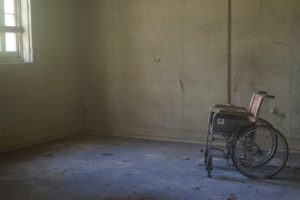
Photo by Doug Maloney on Unsplash
Some folks swim laps. Others water walk and go through exercise routines with buoys, kickboards and weights. They come out of the locker rooms with walkers, canes and wheelchairs. Some need help getting in and out of the pool, or even down to the pool from the parking lot.
For the most part, people who make use of the facility are patient, pleasant and good-natured. Watching them, I wonder at their resilience. What must it be like to be so bent one can only see the floor? How does one cope when the only ambulation possible is to creep along with a walker? The joy and laughter of a wheel-chair bound young person with contorted and twisted limbs like sticks when she’s carried into the therapy pool make me weep.
There’s really no place to hide in the world, at least from ourselves. We all live in a body, and many of us struggle with loving them, including me. We spend an amazing amount of time, money, anguish and effort in disguising our perceived physical defects from the eyes of the world. We tell ourselves nobody can see our shame. No one can see how unlovely or imperfect we really are. No one will ever know.
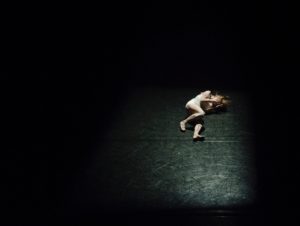
Photo by Hailey Kean on Unsplash
But we know, and our shame and self-loathing poison our lives.
I wonder, as I sit in the chair, what is it about the people who use the pool that enables them to risk physical authenticity? Do they love and accept themselves as they are? If so, how have they developed that ability? Are they unconcerned with what others think of them? Are they like me, and simply resigned to their physical reality, feeling the benefits of using the pool are more important than hiding their appearance, but privately ashamed and embarrassed?
In thinking about this, I realize my own relationship with my body is complicated. On the one hand, I feel affection, loyalty and gratitude. I’ve never aspired to beauty, whatever beauty is. On the other hand, I cringe every time I see a picture of myself, which is not often, as I hate having my picture taken and avoid it whenever possible. I think I cringe because I wish I could protect that vulnerable woman from the eyes and criticism of others. I cringe because my deepest and most private shame is that my physical envelope contains some hidden foulness that makes me unworthy of physical affection and contact. I’m not talking about sex. Sexual attraction and desire are a whole different conversation. I’ve been good enough for sex, but not good enough for consistent loving, nurturing touch. Not good enough to hold.
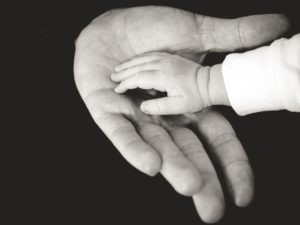
Photo by Liane Metzler on Unsplash
In fact, one of the biggest reasons why I love the water so much is that it touches me.
The shame I feel around this is corrosive and chronic. It’s my intention that it also remain entirely invisible to any onlooker. The pain of this hidden vulnerability of mine enlarges the way I observe others in their bodies. It seems to me we must all have some degree of skin hunger that’s more or less satisfied, depending on our situation. We must all feel some degree of physical isolation and alienation at some point in our lives. Surely every body I see is worthy of care, of love, of touch and nurture, in spite of skin tags, scars, cellulite, bulges and sags, hair distribution or absence, aging, injury and disability, too many or too few pounds.
As I sit on the lifeguard stand, counting heads and scanning the pools, I keep coming back to courage. Courage and humility. The willingness to be seen without the comfort and concealment of clothing. The willingness to be physically authentic and vulnerable. Not a story of courage that will ever be made into a movie, but a kind of daily, humble heroism that touches and inspires me.
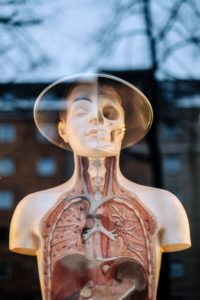
Samuel Zeller on Unsplash
As an observer, it’s effortful to discard childish judgements like “ugly” and “beautiful.” It’s hard not to apply an internalized rating system. I’m tainted by Hollywood, by digitally altered images and by my own private romantic fantasies. Somewhere underneath all the limitations imposed by that conditioning and brainwashing, I glimpse a vast compassionate wisdom encompassing all of us. Life, after all, is beautiful and miraculous. Doing what we can to care for and accept the body we have is an act of courage and strength. Allowing ourselves to be seen and vulnerable takes humility and heroism.
I wonder, somewhat uneasily, if we are no longer able to grasp the beauty inherent in our physical forms. We seem determined to approach the planet’s body, our own and the bodies of others as commodities and resources to plunder, manipulate and then discard when they become boring, worn-out, ill or (at least to our eyes) ugly. Perhaps we’ve lost the ability to appreciate and value everybody in every unique, individual body. Maybe our culture is so injured all we can do now is hate, judge and criticize not only ourselves but others.
Perhaps we’re determined to tear ourselves apart and nothing will stop us.
In the meantime, however, I live in a body, just as you do, and we all have a deeply private and largely invisible relationship with our structure of flesh, blood and bone. My choice is to remain present with the wonder and complexity of the human body, yours, mine and theirs. My choice is to enlarge my compassion and observation until I touch that edge of wisdom that acknowledges beauty and worth in all of physical life, be it human, tree or creature.

Photo by Khoa Pham on Unsplash
All content on this site ©2018
Jennifer Rose
except where otherwise noted
by Jenny Rose | Oct 25, 2018 | A Flourishing Woman, Spirit
The last time my job necessitated driving in the dark, I was a young married woman. I worked afternoons and evenings in a hospital in a large city and drove home on well-lit highways and city streets after the chaos of evening rush hour. I never left the hospital after dark without Security, who saw me safely to my car.

Photo by Peter Forster on Unsplash
As a child I was terrified of the dark. I was a fearful child in general and the dark was the culmination of every nameless horror, imagined and real. Somewhere in the years of early motherhood when I became a single parent my fear of the dark vanished and it became my friend — a place of peace, rest and privacy. It shielded me from critical eyes and harsh words.
If no one could see me or find me, they wouldn’t discover what a failure I was.
After some years of friendship the dark became my lover, and I adorned it with candlelight, welcomed starlight onto my pillow and delighted in night walks. I feel strangely at one with the pale, musky blur of the skunk; the large clumsy rustling and noisy chewing of the bear eating windfall apples and the kingly owls conversing solemnly overhead. The warmly-lit world inside where people talk, laugh, and live their lives is another universe and I a wild, aloof creature, silent and unseen under the grandeur of the night sky.

Photo by Jeremy Thomas on Unsplash
Miracles happen in the dark.
Now I’m driving in the dark again, slipping through the folds and creases of the hills, passing over the river and gliding under the half-naked trees. The small city’s lights glow dimly, behind me if I’m going home after closing the pool, ahead of me if I’m coming in early to open it. The pavement undulates and curves, unfolding under my headlights. Lit windows give me intimate glimpses of people moving around in kitchens and living rooms, sipping from a cup, glancing at a TV screen. Other drivers are out, too, strung loosely along the road. Oncoming headlights force my gaze to the shoulder, scanning for hapless porcupines, impulsive deer or careless pedestrians.
Last night, an almost perfect Hunter’s Moon rose over a stubbled field where corn grew a few weeks ago, lighting a black and white vista of fields and scattered trees. It hung low, gleaming through bare branches, silvering my right shoulder as it saw me home. As I backed into the driveway to park under the friendly light at the apex of the barn roof, moonlight flooded in my windshield as though embracing me before I opened the cellar door and stepped inside the house, no longer half fey and wild but my usual civilized and responsible self.
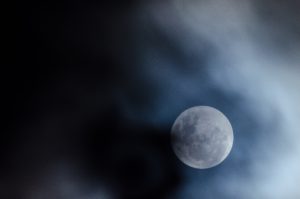
Photo by Linda Xu on Unsplash
This morning, snow and leaves whirled in my headlights and my tires hissed on the wet road. The trees hunched, dark indistinct shapes, and the river was invisible as I crossed the bridge. I opened the car window for the pleasure of the wet snowflakes on my face, the damp autumn smell and the cold lash of dark air on my cheeks. I might have been the only living human being in the world. For a moment I wished it was so. I might have been going anywhere or nowhere through the darkness, the snow and the leaves. It seemed perfectly possible to stop the car and abandon it, to fling myself into the arms of the landscape and disappear into wood, stone, hair and bone.
Yet ahead lay the swimming pool, waiting in the humid darkness of its building for lights to discover it, for people to measure and balance its chemicals, for computer screens to come to life, for the daily schedule to be printed and the showers to be run to prime the hot water. In the town ahead were therapy patients, members of the early water aerobics class and crack-of-dawn lap swimmers. I drive through the dark for them.
So I shook off the wistful feeling that there are other ways to live, deeper, older and more magical, shut the car window and drove on, through the waking town under the dim dawn sky, heavy with downy snow, and stepped into the humid warmth and sound of the swimming pool, blue and white and brightly lit. The darkness and I parted for a time, but it has a piece of me I can give to no one and nothing else. The dark is a lover unlike any other.
I will always return to it.
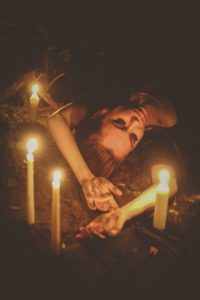
Photo by Miranda Wipperfurth on Unsplash
All content on this site ©2018
Jennifer Rose
except where otherwise noted
by Jenny Rose | Oct 4, 2018 | A Flourishing Woman, The Journey

Photo by Aaron Burden on Unsplash
It’s autumn in central Maine, and the leaves are falling. Sometimes they flutter in the arms of a sly little wind under a crisp blue sky, skittering across the road in front of the car, turning me into a more cautious driver than usual because they look so much like a squirrel or chipmunk. Other days they’re torn from the trees by rain and heavy, tropical air under low grey clouds, misty at their trailing hems.
So many leaves in so many shades of copper, bronze, orange, red and yellow. A sodden chaos of leaves underfoot in the rain and an airy whirlwind of them on dry, bright days. It’s as though the trees have been holding their breath all summer and now they relax and exhale, releasing the tension of production, growth and photosynthesis, easing themselves from yesterday’s clothing and burdens, shaking and stretching in naked freedom and settling down with a sleepy grunt for winter.
Bits of the world, leaves, songs
scatter in painted light.
The days
break. –Carol Frost
The past hours, days, weeks and months litter the ground, trodden, damp and fading. Their stories, whispered to the wind, of nest and hollow; bird, insect and animal; stars and rain and dew and the secret underground life of root, soil and mycelium, are lost. From their bodies new stories for the next cycle and generation of life will green and grow.

Photo by Vanessa von Wieding on Unsplash
I envy the trees their grace and patience. They know how to let go. They turn change into glory. They understand surrender to the fading light and changing tilt of the planet.
I, on the other hand, am not so graceful. Starting a part-time job, even doing something I love and am familiar with, has me wild-eyed and overwhelmed. My carefully constructed and comfortable routine is in pieces. I can’t turn the calendar page and fill in my accustomed schedule. Horrors! Now the days ahead are as naked as the bared trees, allowing me time to reconsider the true shape of things. I think of periods of change as bone time. I can’t see the bones of my life when the calendar is predictable and lists guide me through the day. Habit and routine are powerful, and after a time I stop noticing if I’m staying in balance, managing my time and taking care of my needs well. It’s only in these periods when all my schedules, lists and calendar pages are so many leaves of paper tossed onto the floor that I see the bones again.
To inventory our bones is to let go of possessions, distractions, noise, activity, thoughts, beliefs, habits and behaviors and ask ourselves what our true shape is. What are the deepest pieces of our body and soul? What is necessary in order to express our highest purpose? What destroys our time, energy and joy, and what liberates them?
Can we let go of what’s no longer useful? Can we give it to the wind, to the air, to the frost and rain and snow? Can we give it willingly, freely, with grace and beauty?
Yes, I can let things go.
But grace and beauty are noticeably absent just now!
Still, the trees in this season comfort me and show me the way. They’re not worried about next month, next week or tomorrow. They don’t seem to mind change. They release yesterday’s leaves with careless abandon and show their bones proudly to the sky. They know who they are and they take what they need without apology or shame. They rest in the security of the endlessly turning cycles and seasons.
I don’t think I’ll ever achieve their wisdom or serenity.
On the other hand, I know something about my own bones because life gives most of us more than one chance to begin again, and I’ve had lots of practice. I know shortly I’ll be back in a steady, effective, predictable routine that accommodates my new job as well as my current needs and priorities.
wind tugs leaves away
my hat begs to follow
guide me wind the way
you’re lost i’ll be lost — Kim Robert Stafford
Life is change, and change is life. Old conditions give way to new conditions, and the process is always happening, no matter how stuck or helpless we feel. Chaos comes, picks us up by the scruff of the neck, gives us a good shake, and we find ourselves flung into something new, which will in turn gradually fade away.
Leaves fall. Light wanes. We are lost, torn away from what’s familiar, and then the way ahead opens before us and we’re found again.

Photo by Brigitte Tohm on Unsplash
All content on this site ©2018
Jennifer Rose
except where otherwise noted
by Jenny Rose | Sep 20, 2018 | A Flourishing Woman, Body

Photo by Anna Dziubinska on Unsplash
I hate to shop. I hate the seductive manipulation inherent in the activity. I’m frustrated by the variation in sizes and disgusted by the ridiculous fashions and prices and the terrible quality. My idea of a great shopping experience is to go to Goodwill and find men’s button-down cotton shirts or buy multiples of Carhartt jeans and shorts on sale. Whenever possible, I shop online, concentrating on sales, outlets and brands that emphasize durability, comfort and easy care rather than shoddy glamour.
One of the drawbacks to shopping online is getting the size right in unfamiliar brands. Regular swimmers know swimming suits don’t last. Sun and pool water take a toll quickly. Suits become thin and transparent and loss their elasticity. The fabric breaks down.
Swimming suits are expensive, and they have to fit well or they’re miserable to wear and impossible to swim seriously in. Teeny-weeny bikinis might look great on the right body poolside, but every woman knows actually swimming in them is another matter, and forget about diving. Men’s comfy jeans cover a multitude of body imperfections, but women’s swimsuits are a different story.
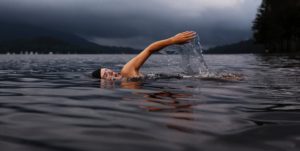
Photo by Todd Quackenbush on Unsplash
All my life I’ve needed a long torso suit, which means fewer choices and more money. When tankinis came out I was delighted because they allow me to wear a regular size, but they’re just as expensive, if not more so, as a standard tank suit. I buy from a big online retailer specializing in all things swimming, and they had a huge Labor Day sale. I was ready. My old suit was beginning to bag, sag and break down.
I shopped for a week, watching prices come down and considering my needs. I finally took the plunge (so to speak) and bought what I wanted. The tankini tops were easy. I’ve worn a 10 in every brand since I was a teenager. No problem. I chose tops that would coordinate with black and got black board shorts for kayaking and black bottoms for swimming. The swim bottoms, however, were an unfamiliar brand. Great price, but unfamiliar brand.
There was a size chart, which I looked at — impatiently. I wanted to make the order and be done with the whole miserable chore. I was pleased to be saving so much money, but I was sick of thinking about swimming suits. I have a sewing tape measure somewhere, but I don’t know exactly where. I had a little construction tape measure in my desk drawer, so I dropped drawers and measured my waist and hips with that. No mirror. Wrong kind of tape measure. Impatient and irritated. According to the size chart, I needed an XL in the swim bottoms. That seemed ridiculous. My ass isn’t that big!
Is it?
Well, I thought, maybe it is. Or maybe the brand I was buying ran really small. My favorite cotton bikini underwear is made in such a way that size 10 is large, not medium. I needed a new suit. I was sick of shopping. I didn’t want the hassle of returning a wrong size, and I didn’t want to refuse to acknowledge the true dimensions of my body out of shame or pride.
So I placed the order and a few days later it arrived. When I unpacked the swim bottoms, they looked huge. I tried them on, over underwear. You couldn’t call them tight, but I thought I could make them work. Everything else was great. I threw away the packing and receipt, discarded my old suit and put my new suit in my swim bag.
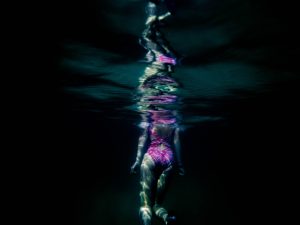
Photo by Jeremy Bishop on Unsplash
Getting into a new swimsuit is like trying to stuff yourself into a spandex straight jacket. Getting out of a new suit that’s wet is even worse. I always wind up giggling and feeling as though I’m wrestling with an anaconda. I suited up, showered and got in the pool, feeling spiffy in my new cobalt blue and black swim gear. I put my goggles on and pushed off the wall. My waistband floated up off my waist, the swim bottoms filled up with water and began to slide gently and elegantly off my ass and down my legs. Whoops!
I stood up, took my goggles off, and yanked the bottoms back up. The pool was not busy. Nobody was paying any attention. I was torn between hilarity and frustration. I really wanted to work out, and I hadn’t brought a spare suit. Dammit, I was going to make these work! Maybe if I didn’t push off the wall with my usual vigor it would help. I put my goggles back on, made sure no one was looking, and pushed off the bottom, gently.
The waistband floated off my waist, the swim bottoms filled with water and started to slide off my ass. I kept going, just to see what would happen. I was swimming freestyle, and the bottoms couldn’t quite slide all the way down my legs. Maybe, I thought, I’m not as exposed as it feels like I am. Maybe from above no one can tell how loose they are. Except that I could feel a big bubble of air trapped between me and the fabric. Bubble butt.
Shit!
I tried tucking the hem of the tankini into the bottoms. No dice. The tankini fit just fine, but it’s not long enough to do more than meet the waistband of the bottoms, especially on me.
I was irresistibly reminded of my youngest son, lifted out of his crib in the morning and toddling down the hallway with his usual sunny-natured glee and his sodden diaper hanging to his knees.
Except his diaper had been white and mine was black.
Shit! Shit! Shit!
I longed to tear the stupid bottoms off and throw them on the deck. I’d rather swim naked any day of the week anyway. Seeing as how I was trying to get hired at this particular pool, I thought that might not create a favorable impression.
I climbed out of the pool via the stairs, holding onto the waistband of my bottoms as unobtrusively as possible, and asked a staff member for a safety pin. Surely they had a safety pin, or even a diaper pin somewhere. Things like safety pins, paperclips and rubber bands are in every desk drawer in the world, aren’t they?
Snorting with laughter, because every woman knows the drill of a sudden broken elastic in a waistband or a bra strap, a broken heel or strap on a shoe, a hem that lets go or a stocking that runs at the worst possible time, the lifeguard searched the desk. No pins.
Another lifeguard suggested a rubber band. Good idea!
No rubber bands.
The second lifeguard reached in her pocket and handed me a covered hair elastic. It was even black!
I pulled in the fabric at the waistband, pinched it together as hard as I could and fastened it with the hair elastic. Now the bottoms were much tighter and I had a thick pigtail of fabric poking out at the waistband. It would be invisible in the water.
I returned to the pool, went through the goggle thing and pushed cautiously off the wall.
Hooray! It worked. There was still a little too much slack in the waistband, but they stayed on and didn’t bubble up.
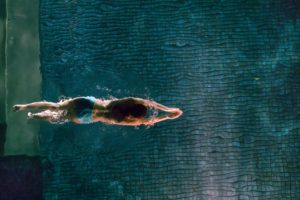
Photo by Chris Kristiansen on Unsplash
In the end, I had a great workout. I returned the hair elastic with thanks when I was finished and then stood in the shower and took several minutes to extricate myself from the tankini top, banging my elbows, writhing, wriggling and squirming. By the time I was free of it, my swim bottoms were around my ankles. No effort required.
Fortunately I have a friend who has a sewing machine. I can sew on a button, mend a simple tear and patch (sort of), but you couldn’t call me a skilled seamstress. I swim again today, and there’s a great big pin in the waistband of my bottoms and a rubber band in my bag, just in case. I also went back to the sale and ordered another pair of bottoms in a smaller size. They were even cheaper.
Here’s what I learned:
- I hate to shop.
- When taking your own measurements, do it with a cloth tape in front of a mirror. Better yet, have someone else do it for the sake of a reality check.
- Don’t throw away packing and receipts until you’ve worn the stupid thing!
- Always carry a couple of safety pins and rubber bands in your swim bag. Consider also Liquid Nails, Super Glue, waterproof duct tape and a staple gun.
- Always carry a spare suit.
- One of the most important keys to life is a sense of humor.
Have I mentioned I loathe shopping?
By the way, I got the job!
All content on this site ©2018
Jennifer Rose
except where otherwise noted


























